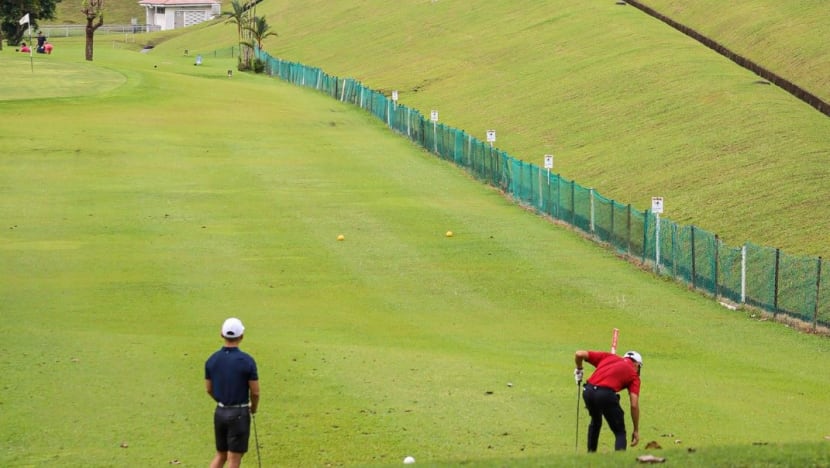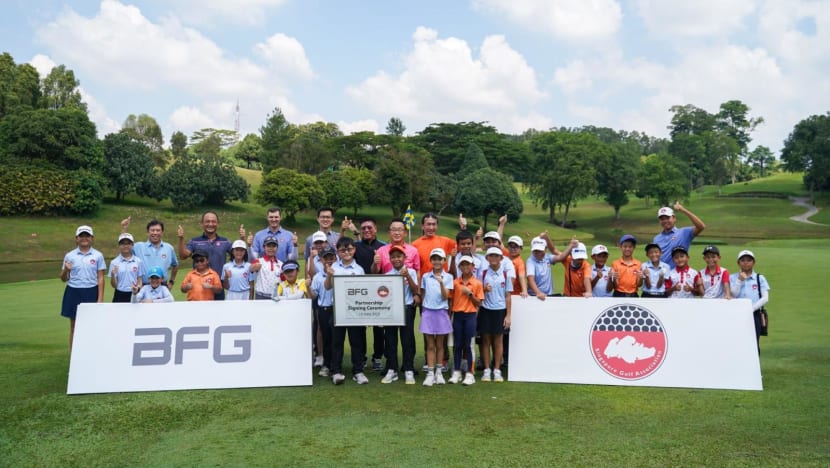IN FOCUS: With all public courses set to close, what is golf's future in Singapore?
As the number of public golf courses dwindles, CNA explores whether interest in the sport can continue to flourish in Singapore

File photo of a golf ball. (Photo: iStock/michaelmjc)
SINGAPORE: What started as a fun pastime where golf coach Daren Lim records videos of himself playing on various courses has now turned into a popular Youtube channel.
Lim’s videos, which now rack up thousands of views, could be a barometer of how interest in the sport in Singapore has picked up pace.
According to the R&A Global Golf Participation Report 2023, the total number of golfers in Singapore was 120,000 in 2022 compared to 80,000 four years before.
While the number of registered golfers has largely remained the same since 2018, the number of non-registered golfers - those without a golf handicap - has ballooned from 40,000 to 80,000.
But whether this interest can be sustained remains a key question, as access to public courses dwindles.
Such courses are seen as a way of getting into the sport as playing on them doesn’t require the high membership fees needed to play at private clubs. They are also seen as helping to change the perception that golf is a rich person’s pastime in Singapore.
THE PROS OF PUBLIC COURSES
Previously, Singapore had 14 private and three public golf courses taking up about 1,465ha of land.
Of the three public courses, Champions Public Golf Course had its last day of operations late last year, while Marina Bay Golf Course will be closing on Jun 30, due to “imminent land lease expiry”.
Then came the news in February that the remaining public course, Mandai Executive Golf Course, would have to make way for a new outdoor adventure learning centre after its tenancy expires at the end of the year.
About two months later, Senior Parliamentary Secretary for the Ministry of Culture, Community and Youth (MCCY) Eric Chua announced in Parliament that the public would be able to play at the course for two additional years, after the operator was granted a tenancy extension until December 2026.
He was responding to a question from Workers’ Party (WP) MP Louis Chua, who had asked if there were plans to convert any of the private golf courses for public use given public course closures, and whether there are plans to ensure that the sport remains accessible to the general public.
Apart from the significantly cheaper prices to tee off, what makes a public course like Mandai special is the fact that beginners can practise there without feeling intimidated, said those who CNA spoke to.
“You can take as much time as you need, no one is going to scold you or chase you,” said WP’s Mr Chua, who started playing golf at Mandai in his university days. “You can learn the sport at your own pace.”
In addition, one also does not need a golf handicap to play at Mandai, unlike other courses, added Mr Lim. “It’s like needing a licence to drive. At Mandai, you don’t need a licence, you can go inside and drive. You can learn as you go and you don’t have to pay so much,” he said.
Last year, the course hosted up to 30 junior programs organised by the Singapore Golf Association (SGA). Over 80,000 golfers play at Mandai Executive Golf Course yearly, the association said.
Public courses like Mandai are important not just to grow the game, they are also vital in the development of young talent.
One young player who benefitted from playing at Mandai is 18-year-old national junior golfer Irvyn Tan, whose sporting journey began at the age of five when he enrolled at a kids golf academy at AMK Hub.
He would then go on to train with Honshin Golf Academy at the Mandai Executive Golf Course.

“Mandai was really, really important because that was where I trained and got my on-course experience from,” said Tan. “It … developed me as a player, how I play on the course, how I … react to different shots and analyse situations.”
“A lot of people still like playing golf, but now the playing opportunities in Singapore are lesser,” professional golfer Mardan Mamat told CNA.
ACCESSIBILITY AND AFFORDABILITY
The growing interest in golf is illustrated not just by participation numbers but by the number of indoor golf facilities which have sprung up over the last few years. These could also be entry points for people looking to get into the sport.
One such facility is GolfX, which caters to a range of golfers from those who play for fun to those who are looking for serious practice.
“Indoor centres like ours … are important for the future of developing golf,” said founder Sid Kim.
“People have a chance to see if they are interested in the sport or not. And without indoor golf there are very, very few opportunities for people to get into it.”
There have also been ground-up initiatives to bring the game to more Singaporeans. Take GolfHub, which was co-founded by 25-year-old Ferris Frederick Francis.
Started 11 months ago, GolfHub's goal is to make the sport accessible to everyone. Mr Francis and his co-founder organise regular gatherings which are held at indoor facilities and driving ranges and those who sign up can play for free with golf clubs and balls fully sponsored.
“It is such an amazing game. (But) because of this mindset that people have cultivated (that it is only for the rich), it is stopping a lot of people from enjoying this game,” he said.
“I feel that if it means me spending about S$100 a week to change their whole perception and doing really good things to impact a lot of people, then I think that is something that I'm so passionate to do.”
Golf coaches such as Mr Lim said that more Singaporeans in their late 20s and early 30s are getting into golf.
“A lot of people (now) realise that this game is not an ‘uncles’ game’ anymore,” added Mr Dalston Koh, who runs SG Golf Coach Academy at Mandai. “It requires a lot of skill, a lot of physical strength, a lot of mobility and it’s a game that youngsters can play.”
“We are very heartened that the growth of the sport is actually quite dynamic,” said SGA president Tan Chong Huat, who described golf as a sport people “gravitate” to.
While some argue that golf is an expensive sport, those who spoke to CNA said that it does not necessarily have to burn a hole in one’s pocket.
The cost to play nine holes at Mandai Executive Course on a weekday is S$38.15, while hitting 120 balls on the driving range costs S$10.50.
Public driving ranges are good entry points for those looking to get into the game, said SGA general manager Joshua Ho.
“When they go to the public facilities like driving ranges and indoor simulators, this is where they can start playing the game and ... get coaching,” he added. “This is where we will come, we create a platform for them to compete.”
This can be in the form of events which SGA organises at various golf courses, explained Mr Ho.
“That’s where they can get the first taste of the golf course, the first taste of competition and also meet like-minded friends,” he added.

When it comes to golf clubs and bags, some start off by buying them second hand.
“If you’re looking to get an entire set of irons and a driver (on Carousell), you can probably get a set for as low as S$250 for a really old set,” explained Mr Francis, who got into the sport while serving his full-time National Service and purchased his equipment used.
“In terms of the cost of starting the game, there is this perception or misconception that you need to buy a full set of brand-new golf clubs, golf bag, golf shoes, you need to buy a membership ... That is not true,” added Mr Ho.
While an hour of golf coaching can range between S$100 to S$200 for an individual, costs are significantly lower if coaching is done in a group.
However, what is undeniable is that when Mandai eventually closes in 2026, it will reduce the options for those who are interested in picking up golf.
The remaining choices include heading to an overseas golf course, trying to book a slot at the private Keppel Club golf course, or booking a tee time at the National Service Resort and Country Club's golf courses (NSRCC) if you are an NSman.
Keppel Club’s Sime course is currently open for both club members as well as the public, with 40 per cent of tee times at the private club allocated to members and the remainder open for public booking.
In comparison to prices at Mandai, the cost for a Singaporean to play nine holes at the Keppel Course on a weekday afternoon is S$60.70 (including buggy fees) while the cost for a Singaporean (non NSman visitor) to play for nine holes at NSRCC is S$106.82.
Then there are private clubs, where club memberships can cost five or even six figure digit dollar sums. It would typically cost hundreds of dollars for a non-member to play on these courses.
“We have customers who come in and come and take lessons who say that: ‘I want to learn golf now because next time I may not have the chance to learn golf’,” said Mr Koh.
One workaround is for golfers to join My Golf Kaki, a club which offers paid memberships to golfers, in turn allowing them access to a number of courses at a discounted rate.

One of the biggest names in local golf over the past few decades, 56-year-old Mardan was reportedly the first local athlete to cross the S$3 million mark in earnings and is a widely recognised figure in the local game.
However, he also started from humble beginnings. As a 13-year-old, he quit primary school to join his elder brother as a caddie at Jurong Country Club, before later honing his skills as a professional golfer at Raffles Country Club.
Without a private club membership, Mardan counts himself fortunate that he was supported by a number of people who recognised his talent, and allowed him access to these courses to practise.
“I was quite fortunate to have people who backed me up at the beginning … really saw my talent and gave me the opportunity to pursue my dream … I really appreciate that,” he said.
“Without them, I don’t know what (I’d be doing today).”

While Mr Lim believes that some Singaporeans will find a way to continue playing golf, he admitted that participation numbers are likely to drop with the closure of the last public course.
And the need for public access has been acknowledged by the authorities.
"Ensuring sustainable development and the efficient use of our limited land is a paramount consideration. Against these parameters, the government is committed to maintaining access to, as well as the development of, the sport of golf," said a SportSG spokesperson in response to queries from CNA.
This includes maximising the availability of spaces for golf, said the spokesperson, citing how the authorities worked Keppel Club to operate the Sime Golf Course - previously used only by a private members club - with a condition to open up part of it for public use at "affordable rates" after Keppel Club's lease at the Bukit Chermin site expired.
The extension of Mandai Executive Golf Course's tenancy is also to "maximise its use for golf until such time the space is needed for other purposes", the spokesperson added.
“In Singapore for one reason or another, it is always seen as an exclusive sport for the rich, for people who have the means. But if you go to the developed markets where golf is played much more regularly or even some of the emerging markets … it is just like any other sport,” said Mr Louis Chua.
“Yes, you can say that because Singapore is very small, we have land constraints … But it doesn’t mean that if we have land or physical constraints, it is only constrained to those who are able to afford it.”
He said what concerned him the most was access to the sport, which is important if Singapore really wants to have a “sporting culture”.
This is a sentiment echoed by others whom CNA spoke to. While they say that golf remains accessible today, it runs the risk of no longer being so once public courses are closed.
“Golf has a reputation for being an ‘elite’ sport but when you have public facilities, public driving ranges and public courses … accessible for anybody without a membership, it’s not an ‘elite’ sport,” said Mr Kim.
“Indoor facilities can supplement golf, but in the end, if there are no public golf courses, then you’re really limiting golf to the elite, which is not what we want to do.”
COMPETING DEMANDS FOR LAND
Another challenge golf faces is the demand for land.
Given that courses take up significant amounts of usable land and are not used by a large majority of the population, the argument is that the land could be put to better uses, such as for housing, schools, healthcare facilities and other amenities to serve the public.
"Golfing is a land-intensive sport. In Singapore, where land is a scarce resource, we have to take care to balance the needs of sports facilities with other critical and competing national demands for land uses, including public housing," said the SportSG spokesperson.
“Given the limited land, it will be harder to keep some of the golf courses, especially those located close to the city centre, where the land costs may have risen significantly, making the land economically unviable to be retained as golf courses,” added NUS Business School professor Sing Tien Foo.
“Other uses, whether housing or infrastructure uses, could be built on the golf course lands to optimise the land value. Urban planners may face the challenge of balancing between the ‘private’ and the ‘public’ benefits from the use of the lands.”
Mr Chow Kim Nam, who is deputy director of Singapore Polytechnic’s (SP) School of Architecture & the Built Environment, said that it is “highly likely” that more golf courses will be repurposed in the future.
“Many viable urban solutions are already at play, including land reclamation, innovative adaptive repurposing of older buildings, mixed-use developments, and intensifying land use,” he said. “However, these have limits in our city-state. Existing golf courses can open more land to be used equitably by the greater population.”
At the same time, golf courses need not always be the first ones to go if land is needed for other developments, said property expert Nicholas Mak, who noted that there are also large tracts of land in Singapore that are zoned as Reserve Sites.
These include reclaimed land and other state land in various parts of Singapore.
While he does not believe that all the golf courses in Singapore will eventually disappear, Mr Mak said that there is a good chance that more eventually will.
“The odds are against the longevity of golf courses,” he added.
Prof Sing, who is the Provost's Chair Professor at NUS’ Department of Real Estate, noted that given the rising costs of land, it will be harder to keep many golf courses for the public, and private golf courses will also have to pay higher rents to keep their courses.
As a result, golfing will be more expensive and more exclusive in Singapore, he added.
“For the golf clubs that are still perceived to be exclusive, the land rents for the golf courses are expected to increase, which will mean that the golf club memberships could become more exclusive to those high-income and high-net-worth people,” explained Prof Sing.
ADDRESSING CHALLENGES AND GROWING TALENT
One way forward is for authorities to work together with private clubs to open up access to non-members. And this is what SGA is doing, said Mr Tan.
It currently collaborates with them to host events and tournaments at their golf courses. For instance, more than 30 tournaments for juniors across various stages of development, will be held this across various golf courses and clubs this year.
SGA high performance training which involves national team members are conducted at a most of the private clubs and the Mandai Executive Course.
While Mr Tan recognises that these clubs have members who pay their monthly dues with exclusivity in mind, he added that they also need to recognise that the game and courses needs to be shared with the public and this could affect the future of their leases.
“We must have this enlightened awareness to work together so that more can enjoy the goodness of golf,” he added.
"We also continue to support the Singapore Golf Association (SGA), as the National Sports Association for golf. The SGA has done good work in providing training and competition access opportunities for our National athletes, both in and out of Singapore," said the SportSG spokesperson.

In 2022, SGA opened its first Centre of Excellence (COE) for the sport at Keppel Club. Keppel Club provides SGA's high performance and junior development programs with access to its driving range and short game practice areas, including the short course.
It also collaborates with organisations such as NTUC Club and the People's Association to conduct “introduction to golf" sessions at locations in the heartlands such as community centres, malls and schools, said Mr Ho.
Improving accessibility and ensuring sustainability of golf facilities is one of the goals of the Golf lndustry Development Task Force (GIDTF), which was established by SGA in 2023.
According to SGA president Mr Tan, the watershed moment will come in several years when the leases on most of the private clubs expire.
“If for all the things that we have discussed, we can change the landscape and perception, golf will have a bright future,” he said.
Describing SGA as "pivotal" in promoting the sport and fostering mass participation, the SportSG spokespersonal said that it has been "instrumental" in developing talent at the grassroots level.
"Sport Singapore is in active discussions with SGA to support its role in maintaining and developing support for the sport in Singapore," the spokesperson added.
"This includes strategies for regional and international events to be held in Singapore, as well as to further develop and promote golf within the local community."
At the moment, it appears that interest remains and there is a pipeline of talent coming through in Singapore.
Just ask Mr Lim, who coaches out of Tanah Merah Country Club. His junior programme which started with 20 students five years ago now has about 65 students and a waitlist.
“I’ve also seen that other programmes are having more kids enrolling, not just mine,” he said. “Our junior competition scene is also very strong … The tournaments are always full.”
“The closure (of Mandai Executive Course) definitely has an impact, but that is really inevitable,” said Mr Tan. “What we need to do is look at the whole of the ecosystem to make up for that limitation. We need to deploy all the resources we have within the ecosystem to make sure we are more effective.”
But ultimate, as with any other sport, golf is a numbers game, he said.
SGA is more than aware of this, said Mr Tan.
“If we don’t get more youth to play the game, we don’t have a big base,” he added.
“We need to ensure there is accessibility, there is this ability to get a bigger pool of youth to come in to play and then … showcase and give more opportunities for the younger athletes to do well.”
“If there is no access that means there are no numbers to play. How do we find talent among such a small pool?” asked Mr Lim.
“You never know, you might have the next Singaporean Tiger Woods out there, but they’ll never ever pick up a club,” added Mr Kim.


















